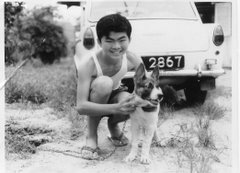Recently I had the pleasure of attending the book launch of The History of Changi at the Changi Museum and took home a tin cup as a souvenir. This tin cup looks just like the ones that folks used during my kampong days in the fifties. Whenever I accompanied my mother to visit our neighbours, they would serve us coffee using a tin cup such as this one, although at that time it looked bigger.

Tin cups or mugs were widely used by kampong folks. They came in an assortment of sizes and designs. I remember we had a neighbour who manufactured tofu in his house. We called him Tau Kua Kwan or Beancurd Kwan in Hokkien. Sometimes, we would buy soya milk from him using a big tin mug. He charged us only 10 cents per mug. Such tin mugs were valued household items. They were often used until the rims and corners got chipped and rusty.
When I grew up and joined the army, one of the first things they issued us recruits was a metal food tray and a gigantic mug. I remember telling myself, "Why on earth do we need such a huge mug?" Well, it didn't take long before I discovered that army trainees have a huge capacity for liquid and that the mug actually wasn't excessively big at all.
And that reminds me of a funny incident that happened in the OCS (Officer Cadet School) cookhouse. On certain days, they served us 'bandung', a drink made from rose syrup and evaporated milk, which the cook scooped from a gigantic tub. After a hard morning of training, the bandung tasted heavenly. Those of us who went to the cookhouse early and were in front of the queue would gulp down the first cup and refilled our mugs on the spot. Owing to our "kiasu-ness" (selfishness) those who came later found that the huge tub of bandung was fast depleting. So what did the cooks do? Simple. They turned on the tap and topped up the tub with a huge rubber hose!
And that reminds me of a tv advertisement of the 70's. At that time, our government was running a "Stop At Two" campaign to discourage couples from having too many babies. There was this advertisement where a family with many children rushed to the dining table to grab the snacks at meal time. A little girl was too slow; and when she reached the table, her older siblings had already grabbed every thing. The pathetic look on her face was unforgettable. "Two is enough. The more you have, the less they get." was the message. I think the advertising agency which produced that ad is the chief culprit for today's baby shortage problem in Singapore. 
On a more serious note, I find that many people of my generation have developed a 'survival of the fittest', 'grab as much as you can' mentality. In today's climate of plenty, some of us who have difficulty discarding this 'kiasu' mentality ended up with a weight problem.
Please pardon me if you find that I am being too judgmental. It could well be a simple case of deferred gratification because it was not uncommon for kids to go to bed empty-stomach in those early days as you can see from this blog article (
Block 13: Humble Beginnings). Consequently, many older Singaporeans have developed a habit of not letting food go to waste. Even in primary school, our children were taught this ancient Chinese poem.
悯农 (by 李绅)
Empathy for Farmers (by Li Shen)
锄禾日当午,
汗滴禾下土。
谁知盘中飧,
粒粒皆辛苦!
Hoeing under the midday sun
Sweat dripping into the tilled soil
Do you know in a plate of riceEvery grain is yielded by such toil.Source: Tang Poems Revisited; Translated by Lien Wen Sze and Foo Check Woo, EPB Publishers Pte Ltd
 If you came to my house you will be surprised to find this dirty old masking tape on one of the doors of my children’s rooms. About eleven years ago when we renovated our house, we gave the contractor strict instructions not to remove this masking tape. Do you know why?
If you came to my house you will be surprised to find this dirty old masking tape on one of the doors of my children’s rooms. About eleven years ago when we renovated our house, we gave the contractor strict instructions not to remove this masking tape. Do you know why?






